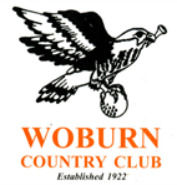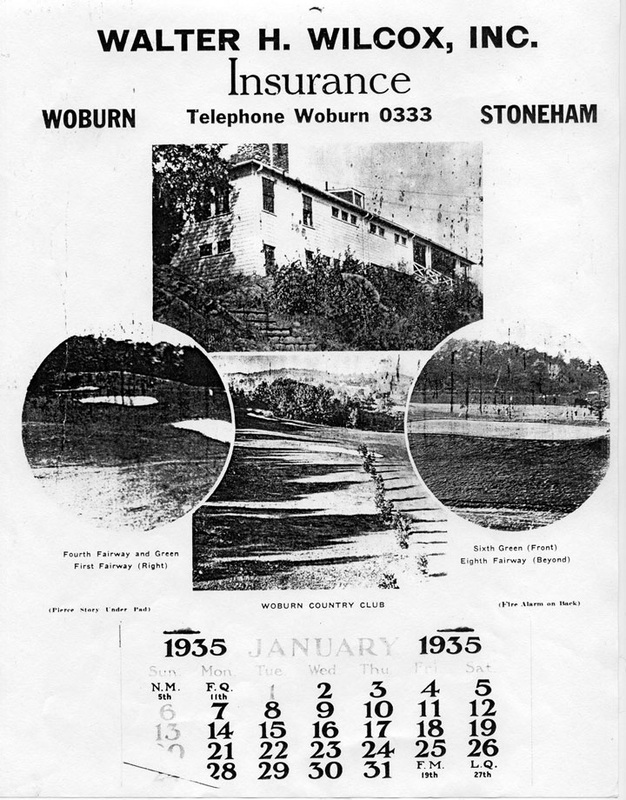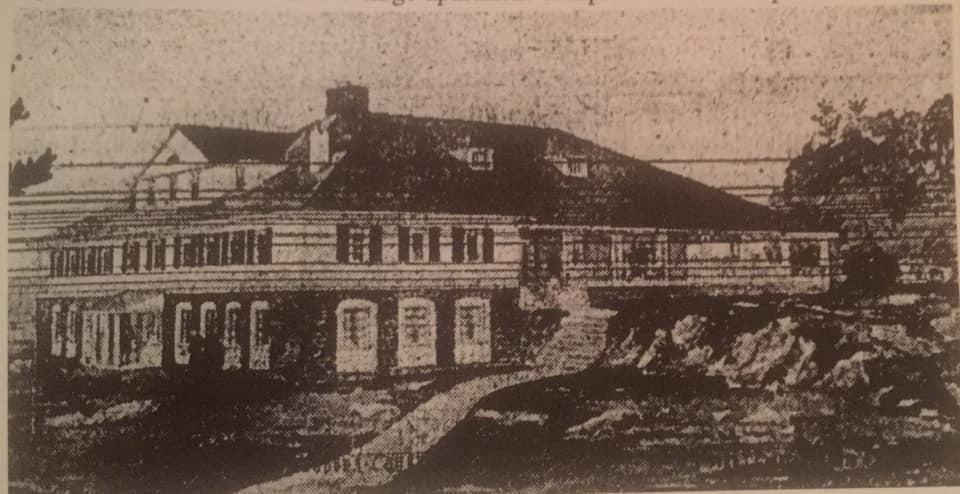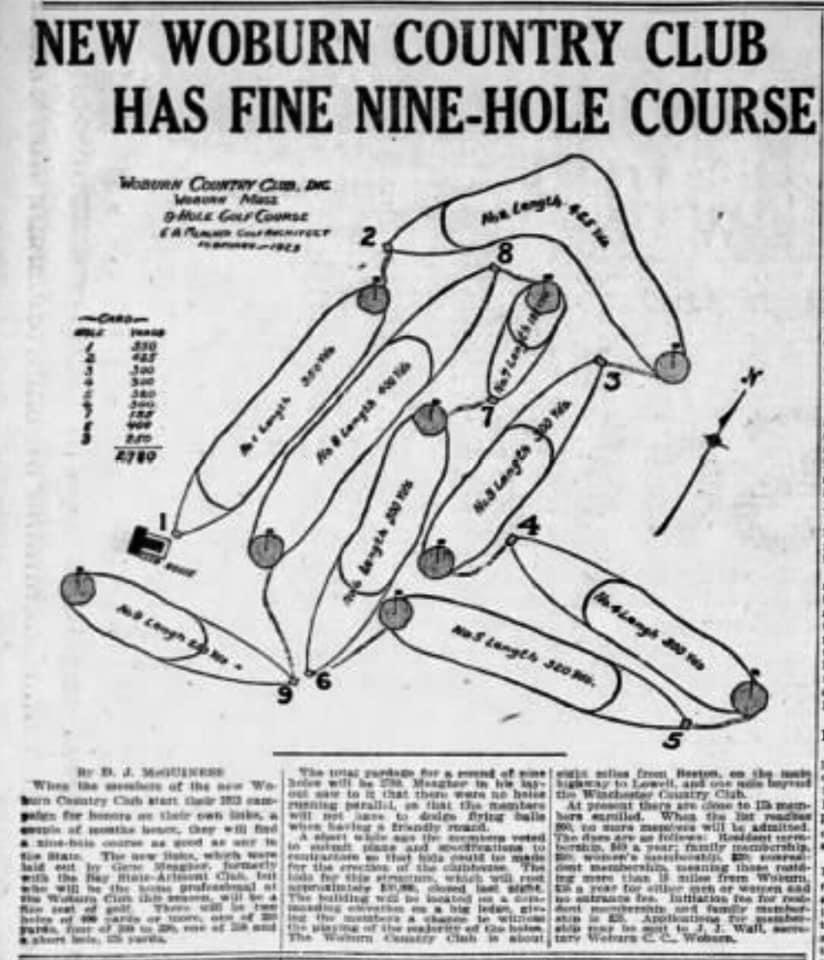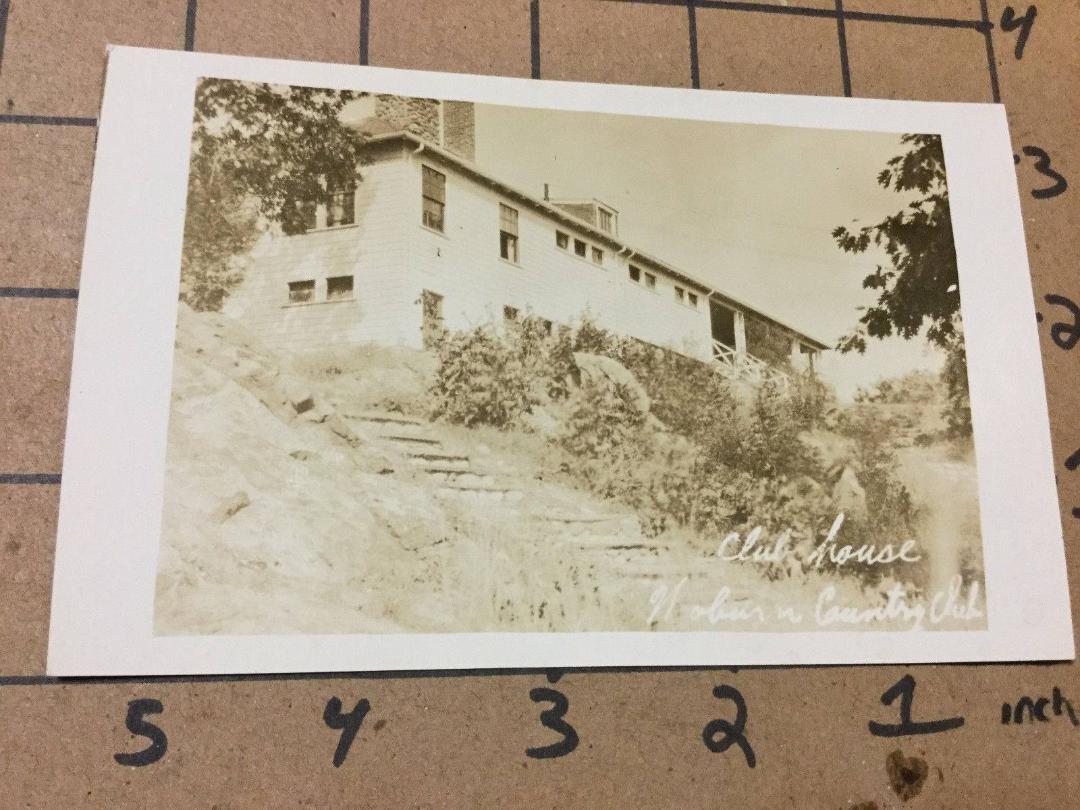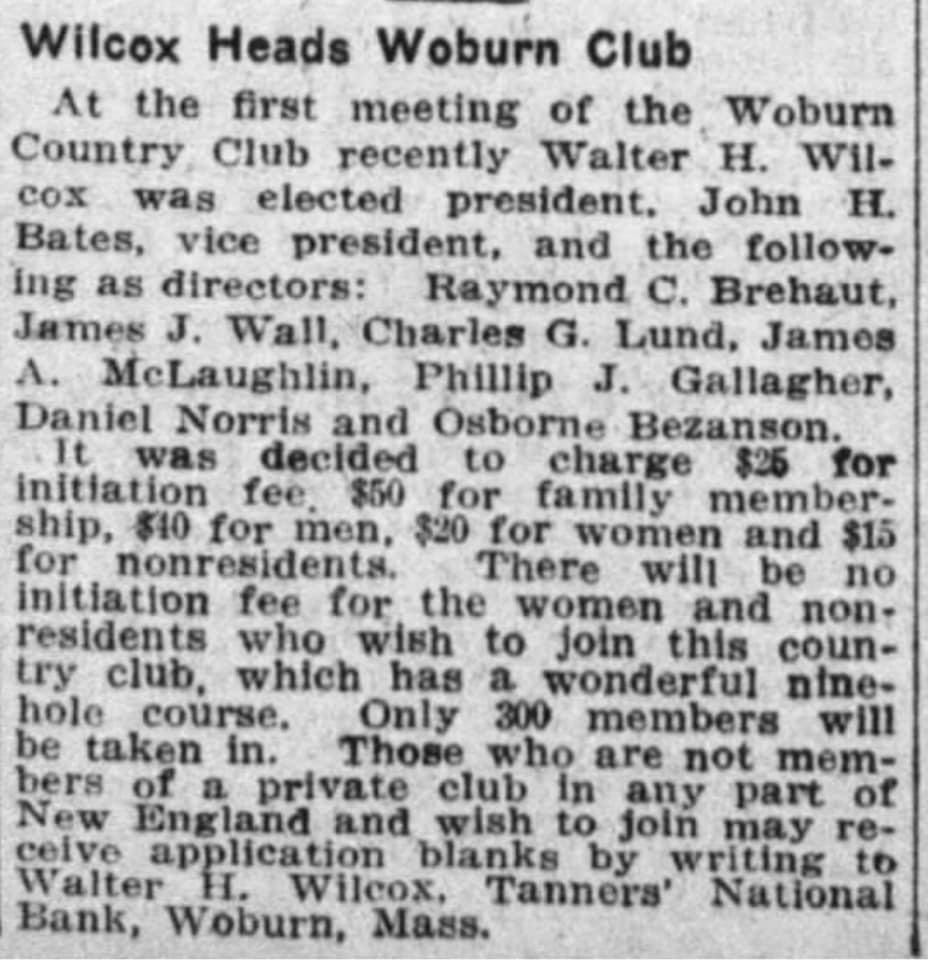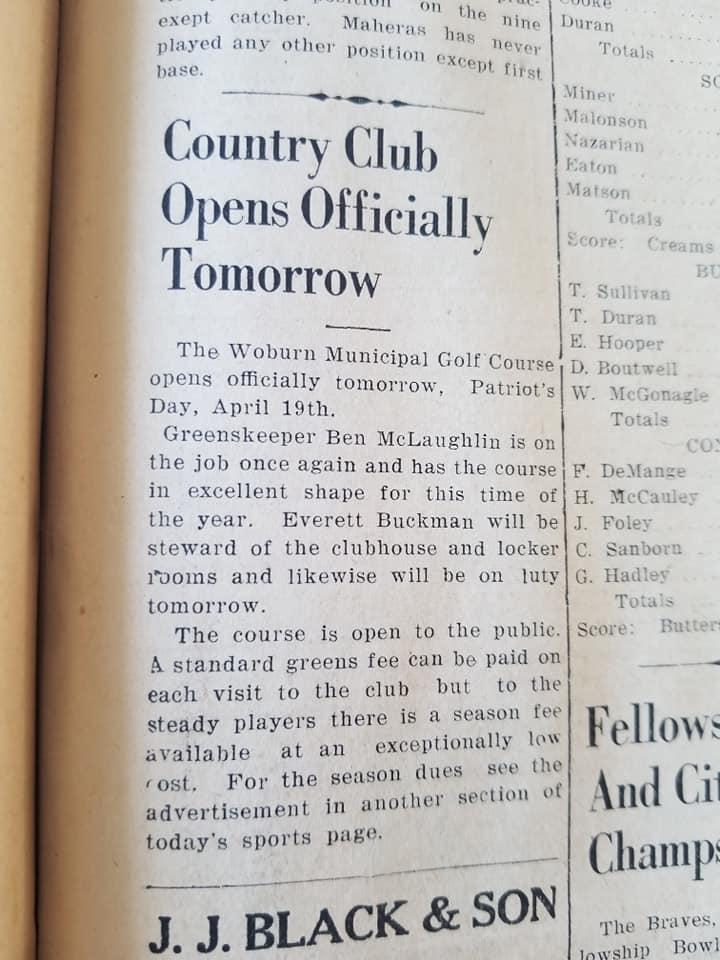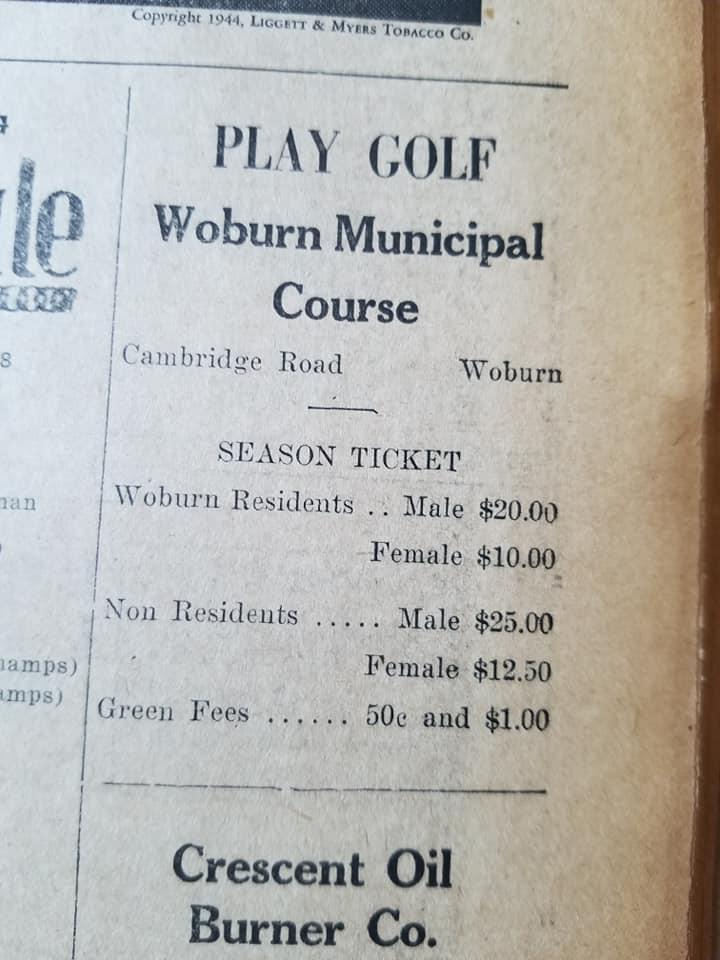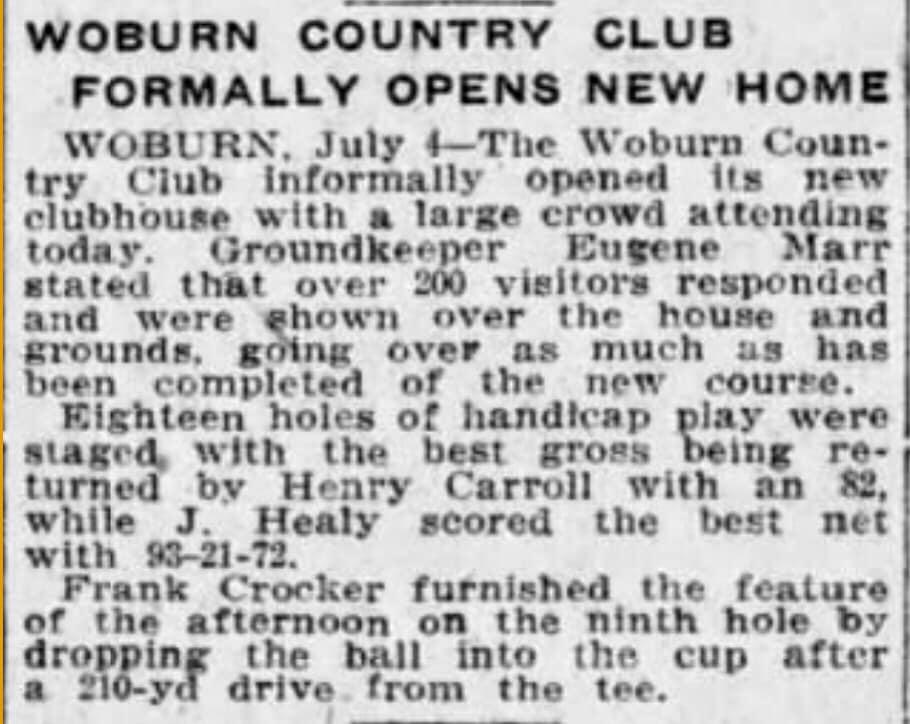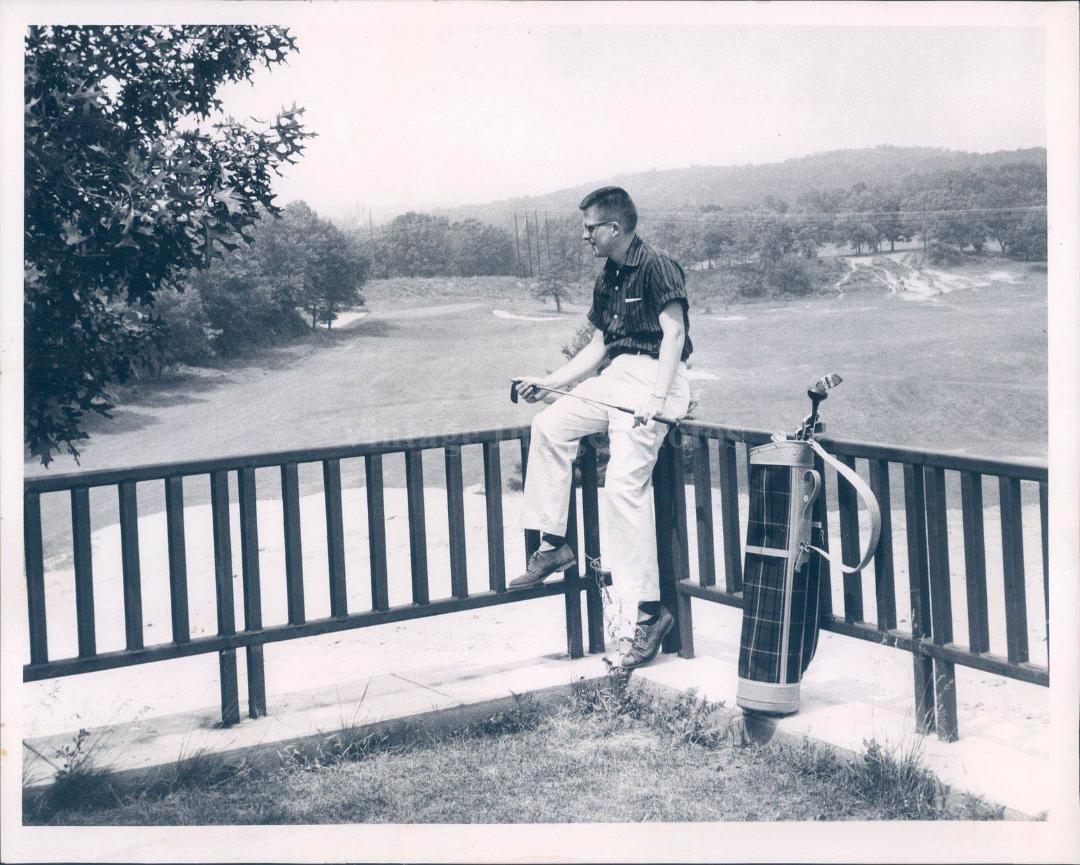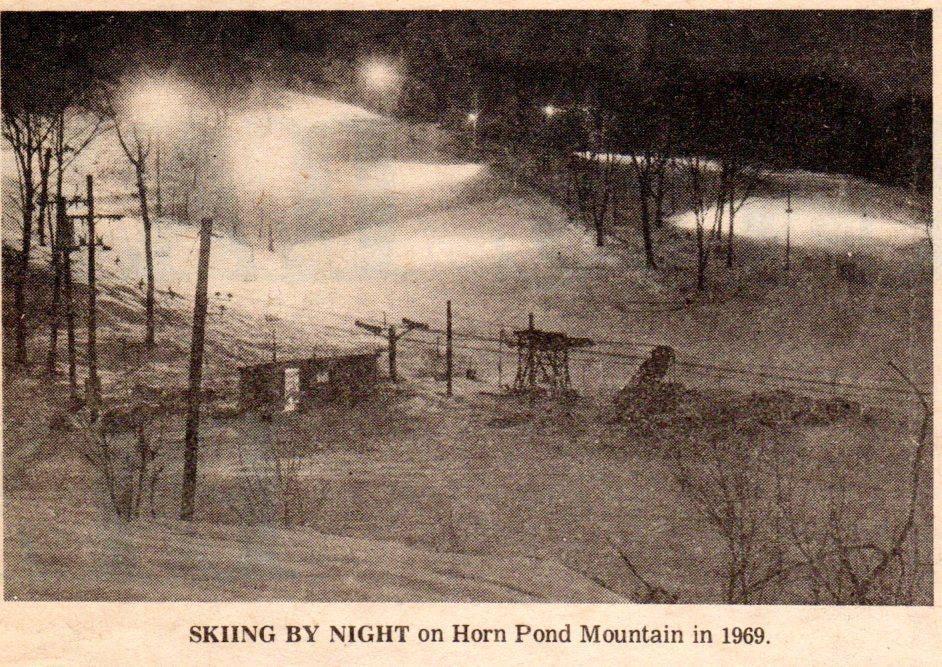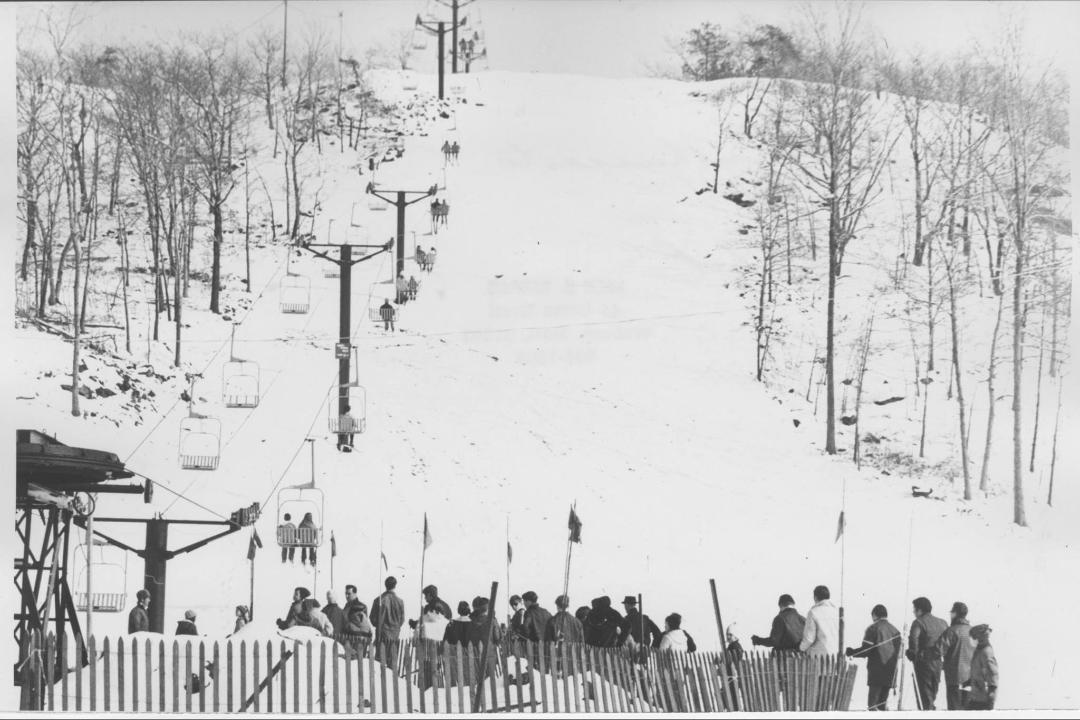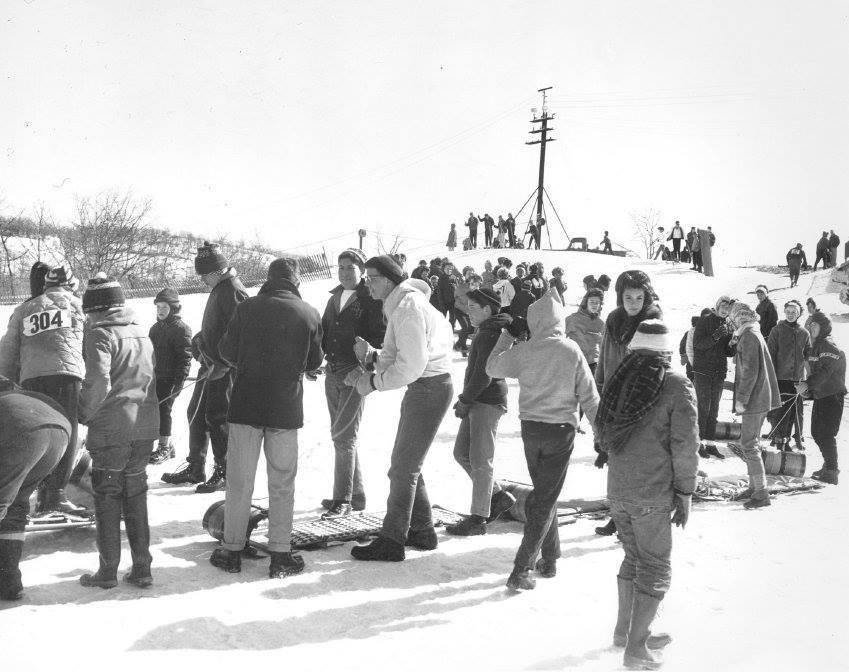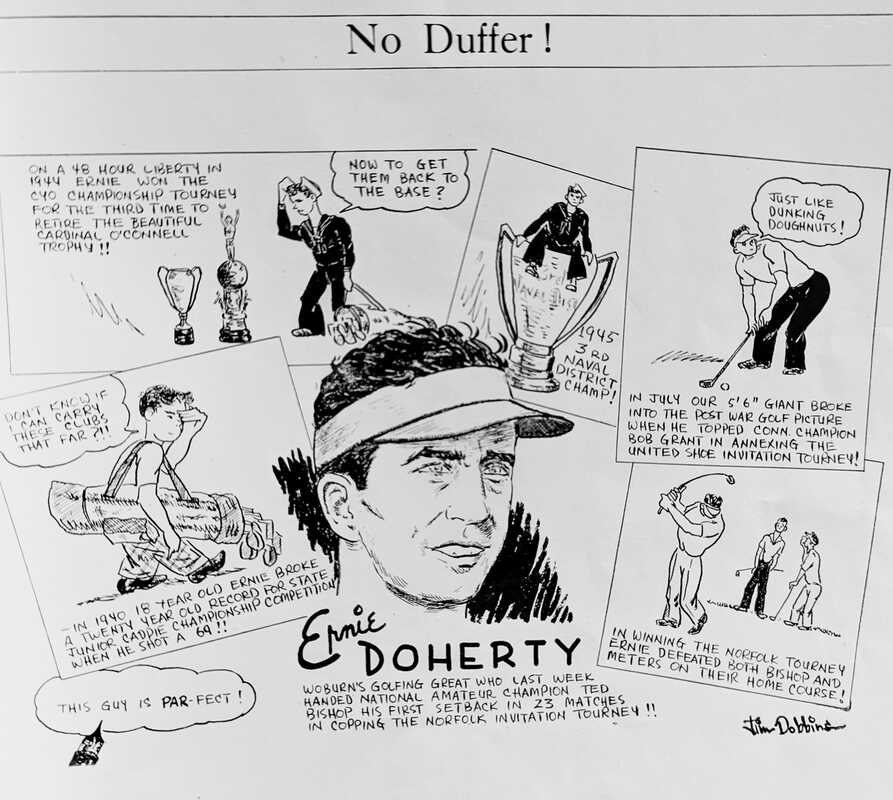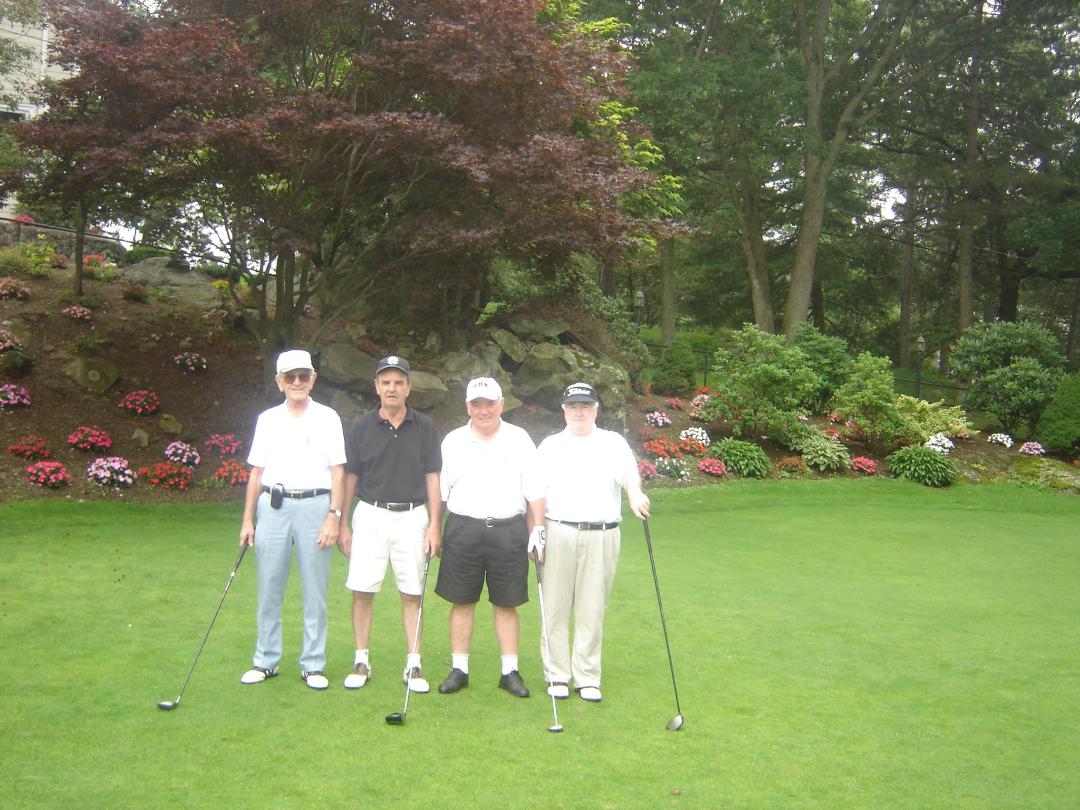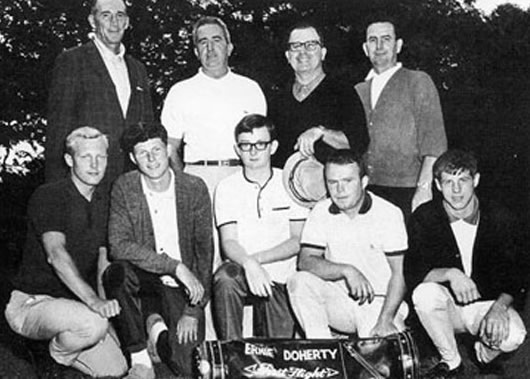
l/r Wm. J. McGarr-Mechanic, Edmund Doherty-Pro Shop Mgr., Ernest Doherty-Pro, Jack Doherty-Ass't. Pro, John Thoren-Ass't Greenskeeper, Don Hearn-Ass't Greenskeeper, William Doherty-Locker Room Attendant, Robert Connolly-Head Greenskeeper, Robert Allen-Ass't Pro Shop Mgr.
Missing:Jim Deveto-Ass't Manager, Ronald Weafer, Jr., Ass't Greenskeeper. 1965.
The Beginning - "Woburn Country Club" a large tact of land near the western side of the Horn Pond was being eyed for its recreational possibilities,albeit by the private sector, and in 1922 several leading businessmen in the City formed a privately owned corporation with the goal of constructing and owning a golf course. Formed the Woburn Country Club with Walter H. Wilcox as the first president, the group had already selected and purchased the site for the course
by November 1922, and began offering membership for the 1923 season. (cost for membership was $60 for
the year for a man, $20 for a woman & $75 for a family.)
The corporation hired the firm of D. McLaughlin and Sons to clear brush and trees for a basic course and
employed Eugene A. Meagher as its first professional greens keeper to lay out some temporary greens.
Six holes were ready by the spring, and the partially completed course opened for play on May 6, 1923,
with ex-Mayor Bernard J. Golden the first officially tee off."
---(Woburn a Past Observed by John McElhiney)
The existence of the Woburn Country Club, between Cambridge Street and the abandoned sand pit area, west of the Pond, creates a wonderful open edge for the woods that surround Hond Pond. An open edge serves to increase the diversifying an area's habitats.---The Great Spirit of Horn Pond by Thomas P. Sileo
Woburn Country Club
Linda Raymond
History of the Woburn Country Club
Woburn Country Club was opened in 1923. The most famous of the local golfers was Ernie Doherty who was the top Junior golfer in the state from 1940-1943. Woburn High School initiated the teaching of golf as far back as 1937 with Woburn CC pro Johnny Thoren. 80 students enrolled for classes in the gym and Tim Ring was the coach.
Another good golfer to come out of the Woburn CC was Phil Friel. As a 19 year old assistant groundskeeper at the club, copped the MA Golf Association Tournament in 1936. He led a field of 41 entrants to win the cup. In 1976 listed as former and current better golfers: John Collition, Bobby and Dick Connolly, Joe Castiglione, Bobby Doherty, Nedda Doherty, Pat Eastman, Dr. Al Flaherty, Dick Foley, Roger Flaherty, Dan Friel, The Gaffney’s Jimmy Sr. & Jr., Dave Johnson, Roger Keefe, , John Keddie, Father Lane, Father Malone, Leo McElhinney, Roger Mulkerrin, Duke McKeaney, John O’Donnell, Joe O’Connor, Tom O’Brien, Nick Sena, Dr. Paul Sherran and Ginger Worth.
Past memories of many holes-in-one at the Woburn CC Roger Keefe, Skip Donohoe, Bud Collins, Joe Fitzgerald and Lucy O’Neill.
Golf once the sport of the idle rich has now become a favorite pastime of the average sportsman.
Woburn Daily Times, April 16,1925:
The Woburn Country Club had its inception in the minds of several Woburn men who had enjoyed the pastime
of golfing for a number of years and became convinced that a golf course within the confines of Woburn would
be a great advantage to the followers of the game and an asset to the city as well. The wisdom and forethought
is best demonstrated by the fact that the converts to this ancient game have been many the past two years.
Michael Gourkes, of Winnmere, an employee at Brookline Country Club for many years was hired as foreman of the gardeners who are laying out the course and constructing the greens and fairways at Woburn Country Club.
* * *The present golf course (April 16, 1925, Woburn Daily Times) comprising between 80 and 90 areas was purchased
from Elmer Dwyer in the spring of 1923. For many years it was known as the estate of the Pierce heirs a name
dating back to the early settlers in Woburn.
Walter H. Wilcox, President of the Tanners National Bank was the leading spirit in the purchase of the tract of land.
His energy in the matter gathered about him a loyal group of friends.
The Woburn Country Club was incorporated and officers and a board of Directors were elected. Walter H. Wilcox was elected president, John H. Bates, vice-president, and James J. Wall secretary. Board of Directors: Walter H. Wilcox, John H. Bates, Philip J. Gallagher, Charles C. Lund, Osborne Bezanson, Raymond C. Brehaut, James A. McLaughlin, and James J. Wall.
In 1923 six holes were graded for play and the fairways cleared as much as practicable. The club house was built the same year. Ferdinand J. Harkins well known in sporting circles as a leader in polo is the steward of the club. Philip J. Gallagher is the present secretary of the club and Dr. Owen J. Logue and Warren M Cox have been added to the directorate. During Edward Kennedy's administration as Mayor, Mr. Wilcox furnished free golf instructions to the students at Woburn high School. The Woburn Country Club would not be here except for the enterprise of Walter Wilcox, who was a golfer of considerable note in his own right. During his presidency of the Woburn Country Club, the following golf professional were developed, probably more than any other club in New England. They are as follows:
* 1. Phil Friel, owner of Green Meadows Country Club, Hudson NH.
* 2. Ernie Doherty, Woburn Country Club, Woburn, Mass.
* 3. Don Nelson, Wright Golf Club, Medford, Mass.
* 4. John Thorean, Pro Hamilton, Mass.
* 5. Jim Gaffiiey, South Shore Country Club.
First Full Season, 1924
In June 1924, the first full season of regular weekly golf tournaments were to be held at the Country Club, which was being called " one of the sportiest courses in the state."
"These tournaments are proving very popular with the members," the Times reported, "and the number of enthusiasts on the links is ample proof that the local golf club has made a permanent place for itself in the social life of the community."---The Great Spirit of Horn Pond.
Woburn Daily Times November 26, 1924.Excellent Nine-Hole Course at Woburn Country Club, Makes Marked Improvement During Past Year.
The local Country Club has made rapid strides the past year and its golf course is now on par with the best nine holes courses in the state. There are four holes that are three hundred yards or over. Two well over two hundred mark and three short holes that average about 150 yards. This gives the course the total yardage of 2330 yards. One can obtain a complete view of the course with the exception of the fourth hole, from the club veranda. Nature has molded the grounds into perfect links except for the finishing process, the hands and device of men. The traps and hazards were the work of elements. In fact a natural golf course existed there long before Woburnites took up the royal and ancient game.
* * *The first hole measures 332 yards from the tee to the cup. A good drive and a well directed brassie shot puts one a position within a chip shot of the green. This green is on a slope which makes it tricky. The wisest player keeps his ball on the near side of the pin.
The next hole measures 351 yards and is the longest on the course. Ample opportunity is given to use the 'Svoods" on this hole. The fairway is wide enough for the poorest duffer and if one goes into the woods on this drive it is indeed a case of needing a pro. The green on this hole is also on a slope and much care must be used to keep the ball on the near side of the cup.
The third hole is a trifle shorter than number one. Eight yards shorter to be exact. The green is not visible from the tee, but an idea can be obtained by stepping a few yards to the left. The player must very careful on this hole as a slight pull will find him in the woods on either side of the narrow fairway. A fairly decent drive usually finds one down in the first hollow, which gives a splendid chance for a high mashie shot to the green. The green is level and very fast. More than one over anxious golfer has been on the green in three and off in four.
The fourth hole is a short one. Only 168 yards, but is the nemesis of many a local golfers. The tee is on sort of a banking that runs down to the marsh. There is fifty yards of this mire, which ends against a sandy wall. This wall rises to a height the same level as the tee, which cuts off ones view of the hole. The green rest in a hollow on the other side of this wall. The trusty old mashie will get you over, but usually Old Man psychology effects the work of your club. Thus lost balls and an irate golfer.
The next hole is a mashie pitch from a tee that towers over the green. It is a scant 112 yards, and acts as a soother to the duffer who has blown up on the hole before.
The sixth hole is 264 yards away and there is enough distance for a wood shot, but some of the hardened golfers prefer an iron here. The fairway is plenty wide, but a not a few find it to narrow and consequently get into trouble, or rather into the woods. There is a mental hazard in front of the tee, which consist of a brook and marsh. Not a bad hazard, but then. The green on this hole rises up about twenty feet^which gives one a chance to make a wonderful pitch shot with a niblick. There is plenty of space on this green and there is not any need of being afraid of over reaching it.
The seventh hole is nothing out of the ordinary. The woods on the left prove to be Jonah to some of the players, but as a rule they feel sort of secure on this hole.
The next hole is over 300 yards from the tee. This affords plenty of space fro a nice drive provided one keeps out of the trees on the left. However, this piece of woods seems to be a magnet for the little white pill.
The ninth hole is last but not least. It has proved to be many a person Water-loo. For a water hazard it is. The distance between the tees and the flag is only 195 yards, but again psychology resigns, and as some say their ardor for golf is dampened considerably on this hole. The pond covers about seventy-five square yards in front of the tee. And a most bothersome seventy-five yards it proves.
Woburn Daily Times, May 1st, 1925:
Woburn Country Club will make changes in course new play about July 1st. Preparations to greens and fairways promise an ideal golf course.
The Woburn Country Club is preparing for a record season. Green keeper Fredie Harkins has the club property in fine trim for the season which just opened, and many of the rough spots of previous years will be high class shape for many matches which will be staged during the approaching summer months. Considerable time and effort have been devoted in shaping the greens and fairways.
Those who are familiar with the course will find some material changes in the arrangement of the course. Hole number 2 which has been center of professional effort will be ready for play about July 1st, the fairway and green have been sown and the club directors feel quite proud of the natural results which will follow the treatment of the course when the new hole is ready for play, the short temporary hole now being played at number 5 will be discontinued and the play will be changed as follows: present number 6 will then become permanent number 3, and present hole number 7 and 8 will become permanent number 4 and 5 respectively; present hole number 3 will become permanent number 6, present hole number 4 (known as the Bowl Hole) will become permanent number 7 and the hole now played at number 2 will become hole number 8, the present number 9 will remain the same.
The arrangements have been made according to the original plans of the course, and the members have looking forward to anticipation to the full nine hole course, which will be open on July 1st.
Woburn 100 Years Ago by Alfred E. Newall
The present Woburn Country Club was the home of Nathan Pierce. Alfred E. Newall, the historian in his "Woburn 100 Years Ago," stated that Nathan liked to enjoy the charms of solitude cultivating a little land about him for his support, not troubling with what the outside world was doing;" while Grandma Pierce was braiding husks and making what she called 'maps' t sell to the townspeople." The Historian further states, "we follow the path that comes out near Jacob Pierce's where are the remains of an old Pierce house, probably where Jacob was born."
The path referred to is a winding one along the north side of Horn Pond Mountain, bordering on farmland (The number 5 fairway if the Country Club today). The traveler can easily see the Country Club house, located on the high ledge towards the west, 200 yards from Cambridge Road.
Nestled in the sunny valley on the southern exposure over a century ago stood the house that was spoken of as the "house where Jacob Pierce was born." The foundation lines of the house are still visible. (Overlooking the 9th fairway.) The foundation walls of the great barn can be seen 500 feet to the north (near the 8* fairway). An inspection of the walls would indicate that a great amount of labor was involved in the sturdy construction, measurements showing a building 50 feet square, the owner selecting a sheltered spot under the high ledge for the barn. The cart path referred to above wound its way across the farm, coming out near the Jacob pierce farmhouse on the main highway. Route 3. This farmhouse was a slightly structure, with a large barn and other buildings which are not now standing.
The Woburn Country Club acquired the Pierce estate by purchase in 1922. The golf course is considered one of the finest nine-hole courses in the vicinity of Boston. The greens are exceptionally well cared for and the Country club is efficiently managed...
Jacob Pierce was Elmore Pierce's father and when he died Elmore ran an experimental farm on that land. He also donated much of the land that is now Horn Pond conservation land and got together the support needed for the City to purchase what is now Ice House Park and Hudson's Grove. He was instrumental in urging the City to purchase the 27 acres on the westerly side of Horn Pond that now adjoin the Woburn Country Club. Years late, in 1919, he finally managed to convince the City Council that it was in there best interest to purchase the land before it ended up in the hands of developers and polluters. He than added, let us rally to prevent Woburn's greatest and most attractive beauty spot, the parkway and surroundings from being despoiled.
When the City Council finally agreed they ended up paying^the paltry sum of $2,700 for a treasure that to those who frequent Horn Pond and its pathways know full well is priceless.
Some history from "The Great Spirit of Horn Pond" by Thomas P. Sileo
The Depression of the 1930s
The Woburn Country Club, along with many golf clubs throughout New England, was hit hard by the Great Depression. Members, no longer able to afford the extravagance of playing a round of golf, dropped out rapidly. Soon the club could no longer afford to operate.
Unable to pay their taxes, the Club's land, including the nine holes, the club house, and close to 200 areas of land, stretching from just west of the Pond to Cambridge Road, was taken by the City of Woburn as a tax-title lot. From 1934, the club was leased out to a professional golf club operator at the decretion of the Mayor.
During that period, pieces of the Club's land were sold to developers, including the site of the New England Rehabilitation Hospital, and land west of the nine holes on which housing developments have been built, including Ledgewood Road, Country Club Road, Hiawatha Road, and others.
Golf and Ski Authority, 1968
By the mid-1960s, it was generally felt that the golf course should be operated by the City rather then being leased out by the Mayor. In response to this, Mayor Edward F. Gill established the Golf and Ski Authority in 1968. Officials were to be appointed to run the day-to-day operation of the Golf Club, but no appointments were made the first two years. Then the next three years, various conflicts, particularly arguments between the newly formed Authority and the Country Club, Inc., who helded a long-term lease which expires in 1974.
Finally, in 1973, nine officials were appointed and the Golf & Ski Authority took over the golf course. Their first day's profits amounted to $8, but today, with 3200-3500 rounds of golf a year played on the course, the operation is considered a successful business.
Special thanks to Marie Coady and acknowledgments to Woburn Daily Times, Woburn Public Library, "Woburn a Past Observed" by John McElhiney, "Woburn 100 Years Ago" by Alfred E. Newall, "The Great Spirit of Horn Pond by Thomas P. Sileo, and others...
Charles T. Culhane Woburn, Ma 01801
by November 1922, and began offering membership for the 1923 season. (cost for membership was $60 for
the year for a man, $20 for a woman & $75 for a family.)
The corporation hired the firm of D. McLaughlin and Sons to clear brush and trees for a basic course and
employed Eugene A. Meagher as its first professional greens keeper to lay out some temporary greens.
Six holes were ready by the spring, and the partially completed course opened for play on May 6, 1923,
with ex-Mayor Bernard J. Golden the first officially tee off."
---(Woburn a Past Observed by John McElhiney)
The existence of the Woburn Country Club, between Cambridge Street and the abandoned sand pit area, west of the Pond, creates a wonderful open edge for the woods that surround Hond Pond. An open edge serves to increase the diversifying an area's habitats.---The Great Spirit of Horn Pond by Thomas P. Sileo
Woburn Country Club
Linda Raymond
History of the Woburn Country Club
Woburn Country Club was opened in 1923. The most famous of the local golfers was Ernie Doherty who was the top Junior golfer in the state from 1940-1943. Woburn High School initiated the teaching of golf as far back as 1937 with Woburn CC pro Johnny Thoren. 80 students enrolled for classes in the gym and Tim Ring was the coach.
Another good golfer to come out of the Woburn CC was Phil Friel. As a 19 year old assistant groundskeeper at the club, copped the MA Golf Association Tournament in 1936. He led a field of 41 entrants to win the cup. In 1976 listed as former and current better golfers: John Collition, Bobby and Dick Connolly, Joe Castiglione, Bobby Doherty, Nedda Doherty, Pat Eastman, Dr. Al Flaherty, Dick Foley, Roger Flaherty, Dan Friel, The Gaffney’s Jimmy Sr. & Jr., Dave Johnson, Roger Keefe, , John Keddie, Father Lane, Father Malone, Leo McElhinney, Roger Mulkerrin, Duke McKeaney, John O’Donnell, Joe O’Connor, Tom O’Brien, Nick Sena, Dr. Paul Sherran and Ginger Worth.
Past memories of many holes-in-one at the Woburn CC Roger Keefe, Skip Donohoe, Bud Collins, Joe Fitzgerald and Lucy O’Neill.
Golf once the sport of the idle rich has now become a favorite pastime of the average sportsman.
Woburn Daily Times, April 16,1925:
The Woburn Country Club had its inception in the minds of several Woburn men who had enjoyed the pastime
of golfing for a number of years and became convinced that a golf course within the confines of Woburn would
be a great advantage to the followers of the game and an asset to the city as well. The wisdom and forethought
is best demonstrated by the fact that the converts to this ancient game have been many the past two years.
Michael Gourkes, of Winnmere, an employee at Brookline Country Club for many years was hired as foreman of the gardeners who are laying out the course and constructing the greens and fairways at Woburn Country Club.
* * *The present golf course (April 16, 1925, Woburn Daily Times) comprising between 80 and 90 areas was purchased
from Elmer Dwyer in the spring of 1923. For many years it was known as the estate of the Pierce heirs a name
dating back to the early settlers in Woburn.
Walter H. Wilcox, President of the Tanners National Bank was the leading spirit in the purchase of the tract of land.
His energy in the matter gathered about him a loyal group of friends.
The Woburn Country Club was incorporated and officers and a board of Directors were elected. Walter H. Wilcox was elected president, John H. Bates, vice-president, and James J. Wall secretary. Board of Directors: Walter H. Wilcox, John H. Bates, Philip J. Gallagher, Charles C. Lund, Osborne Bezanson, Raymond C. Brehaut, James A. McLaughlin, and James J. Wall.
In 1923 six holes were graded for play and the fairways cleared as much as practicable. The club house was built the same year. Ferdinand J. Harkins well known in sporting circles as a leader in polo is the steward of the club. Philip J. Gallagher is the present secretary of the club and Dr. Owen J. Logue and Warren M Cox have been added to the directorate. During Edward Kennedy's administration as Mayor, Mr. Wilcox furnished free golf instructions to the students at Woburn high School. The Woburn Country Club would not be here except for the enterprise of Walter Wilcox, who was a golfer of considerable note in his own right. During his presidency of the Woburn Country Club, the following golf professional were developed, probably more than any other club in New England. They are as follows:
* 1. Phil Friel, owner of Green Meadows Country Club, Hudson NH.
* 2. Ernie Doherty, Woburn Country Club, Woburn, Mass.
* 3. Don Nelson, Wright Golf Club, Medford, Mass.
* 4. John Thorean, Pro Hamilton, Mass.
* 5. Jim Gaffiiey, South Shore Country Club.
First Full Season, 1924
In June 1924, the first full season of regular weekly golf tournaments were to be held at the Country Club, which was being called " one of the sportiest courses in the state."
"These tournaments are proving very popular with the members," the Times reported, "and the number of enthusiasts on the links is ample proof that the local golf club has made a permanent place for itself in the social life of the community."---The Great Spirit of Horn Pond.
Woburn Daily Times November 26, 1924.Excellent Nine-Hole Course at Woburn Country Club, Makes Marked Improvement During Past Year.
The local Country Club has made rapid strides the past year and its golf course is now on par with the best nine holes courses in the state. There are four holes that are three hundred yards or over. Two well over two hundred mark and three short holes that average about 150 yards. This gives the course the total yardage of 2330 yards. One can obtain a complete view of the course with the exception of the fourth hole, from the club veranda. Nature has molded the grounds into perfect links except for the finishing process, the hands and device of men. The traps and hazards were the work of elements. In fact a natural golf course existed there long before Woburnites took up the royal and ancient game.
* * *The first hole measures 332 yards from the tee to the cup. A good drive and a well directed brassie shot puts one a position within a chip shot of the green. This green is on a slope which makes it tricky. The wisest player keeps his ball on the near side of the pin.
The next hole measures 351 yards and is the longest on the course. Ample opportunity is given to use the 'Svoods" on this hole. The fairway is wide enough for the poorest duffer and if one goes into the woods on this drive it is indeed a case of needing a pro. The green on this hole is also on a slope and much care must be used to keep the ball on the near side of the cup.
The third hole is a trifle shorter than number one. Eight yards shorter to be exact. The green is not visible from the tee, but an idea can be obtained by stepping a few yards to the left. The player must very careful on this hole as a slight pull will find him in the woods on either side of the narrow fairway. A fairly decent drive usually finds one down in the first hollow, which gives a splendid chance for a high mashie shot to the green. The green is level and very fast. More than one over anxious golfer has been on the green in three and off in four.
The fourth hole is a short one. Only 168 yards, but is the nemesis of many a local golfers. The tee is on sort of a banking that runs down to the marsh. There is fifty yards of this mire, which ends against a sandy wall. This wall rises to a height the same level as the tee, which cuts off ones view of the hole. The green rest in a hollow on the other side of this wall. The trusty old mashie will get you over, but usually Old Man psychology effects the work of your club. Thus lost balls and an irate golfer.
The next hole is a mashie pitch from a tee that towers over the green. It is a scant 112 yards, and acts as a soother to the duffer who has blown up on the hole before.
The sixth hole is 264 yards away and there is enough distance for a wood shot, but some of the hardened golfers prefer an iron here. The fairway is plenty wide, but a not a few find it to narrow and consequently get into trouble, or rather into the woods. There is a mental hazard in front of the tee, which consist of a brook and marsh. Not a bad hazard, but then. The green on this hole rises up about twenty feet^which gives one a chance to make a wonderful pitch shot with a niblick. There is plenty of space on this green and there is not any need of being afraid of over reaching it.
The seventh hole is nothing out of the ordinary. The woods on the left prove to be Jonah to some of the players, but as a rule they feel sort of secure on this hole.
The next hole is over 300 yards from the tee. This affords plenty of space fro a nice drive provided one keeps out of the trees on the left. However, this piece of woods seems to be a magnet for the little white pill.
The ninth hole is last but not least. It has proved to be many a person Water-loo. For a water hazard it is. The distance between the tees and the flag is only 195 yards, but again psychology resigns, and as some say their ardor for golf is dampened considerably on this hole. The pond covers about seventy-five square yards in front of the tee. And a most bothersome seventy-five yards it proves.
Woburn Daily Times, May 1st, 1925:
Woburn Country Club will make changes in course new play about July 1st. Preparations to greens and fairways promise an ideal golf course.
The Woburn Country Club is preparing for a record season. Green keeper Fredie Harkins has the club property in fine trim for the season which just opened, and many of the rough spots of previous years will be high class shape for many matches which will be staged during the approaching summer months. Considerable time and effort have been devoted in shaping the greens and fairways.
Those who are familiar with the course will find some material changes in the arrangement of the course. Hole number 2 which has been center of professional effort will be ready for play about July 1st, the fairway and green have been sown and the club directors feel quite proud of the natural results which will follow the treatment of the course when the new hole is ready for play, the short temporary hole now being played at number 5 will be discontinued and the play will be changed as follows: present number 6 will then become permanent number 3, and present hole number 7 and 8 will become permanent number 4 and 5 respectively; present hole number 3 will become permanent number 6, present hole number 4 (known as the Bowl Hole) will become permanent number 7 and the hole now played at number 2 will become hole number 8, the present number 9 will remain the same.
The arrangements have been made according to the original plans of the course, and the members have looking forward to anticipation to the full nine hole course, which will be open on July 1st.
Woburn 100 Years Ago by Alfred E. Newall
The present Woburn Country Club was the home of Nathan Pierce. Alfred E. Newall, the historian in his "Woburn 100 Years Ago," stated that Nathan liked to enjoy the charms of solitude cultivating a little land about him for his support, not troubling with what the outside world was doing;" while Grandma Pierce was braiding husks and making what she called 'maps' t sell to the townspeople." The Historian further states, "we follow the path that comes out near Jacob Pierce's where are the remains of an old Pierce house, probably where Jacob was born."
The path referred to is a winding one along the north side of Horn Pond Mountain, bordering on farmland (The number 5 fairway if the Country Club today). The traveler can easily see the Country Club house, located on the high ledge towards the west, 200 yards from Cambridge Road.
Nestled in the sunny valley on the southern exposure over a century ago stood the house that was spoken of as the "house where Jacob Pierce was born." The foundation lines of the house are still visible. (Overlooking the 9th fairway.) The foundation walls of the great barn can be seen 500 feet to the north (near the 8* fairway). An inspection of the walls would indicate that a great amount of labor was involved in the sturdy construction, measurements showing a building 50 feet square, the owner selecting a sheltered spot under the high ledge for the barn. The cart path referred to above wound its way across the farm, coming out near the Jacob pierce farmhouse on the main highway. Route 3. This farmhouse was a slightly structure, with a large barn and other buildings which are not now standing.
The Woburn Country Club acquired the Pierce estate by purchase in 1922. The golf course is considered one of the finest nine-hole courses in the vicinity of Boston. The greens are exceptionally well cared for and the Country club is efficiently managed...
Jacob Pierce was Elmore Pierce's father and when he died Elmore ran an experimental farm on that land. He also donated much of the land that is now Horn Pond conservation land and got together the support needed for the City to purchase what is now Ice House Park and Hudson's Grove. He was instrumental in urging the City to purchase the 27 acres on the westerly side of Horn Pond that now adjoin the Woburn Country Club. Years late, in 1919, he finally managed to convince the City Council that it was in there best interest to purchase the land before it ended up in the hands of developers and polluters. He than added, let us rally to prevent Woburn's greatest and most attractive beauty spot, the parkway and surroundings from being despoiled.
When the City Council finally agreed they ended up paying^the paltry sum of $2,700 for a treasure that to those who frequent Horn Pond and its pathways know full well is priceless.
Some history from "The Great Spirit of Horn Pond" by Thomas P. Sileo
The Depression of the 1930s
The Woburn Country Club, along with many golf clubs throughout New England, was hit hard by the Great Depression. Members, no longer able to afford the extravagance of playing a round of golf, dropped out rapidly. Soon the club could no longer afford to operate.
Unable to pay their taxes, the Club's land, including the nine holes, the club house, and close to 200 areas of land, stretching from just west of the Pond to Cambridge Road, was taken by the City of Woburn as a tax-title lot. From 1934, the club was leased out to a professional golf club operator at the decretion of the Mayor.
During that period, pieces of the Club's land were sold to developers, including the site of the New England Rehabilitation Hospital, and land west of the nine holes on which housing developments have been built, including Ledgewood Road, Country Club Road, Hiawatha Road, and others.
Golf and Ski Authority, 1968
By the mid-1960s, it was generally felt that the golf course should be operated by the City rather then being leased out by the Mayor. In response to this, Mayor Edward F. Gill established the Golf and Ski Authority in 1968. Officials were to be appointed to run the day-to-day operation of the Golf Club, but no appointments were made the first two years. Then the next three years, various conflicts, particularly arguments between the newly formed Authority and the Country Club, Inc., who helded a long-term lease which expires in 1974.
Finally, in 1973, nine officials were appointed and the Golf & Ski Authority took over the golf course. Their first day's profits amounted to $8, but today, with 3200-3500 rounds of golf a year played on the course, the operation is considered a successful business.
Special thanks to Marie Coady and acknowledgments to Woburn Daily Times, Woburn Public Library, "Woburn a Past Observed" by John McElhiney, "Woburn 100 Years Ago" by Alfred E. Newall, "The Great Spirit of Horn Pond by Thomas P. Sileo, and others...
Charles T. Culhane Woburn, Ma 01801
